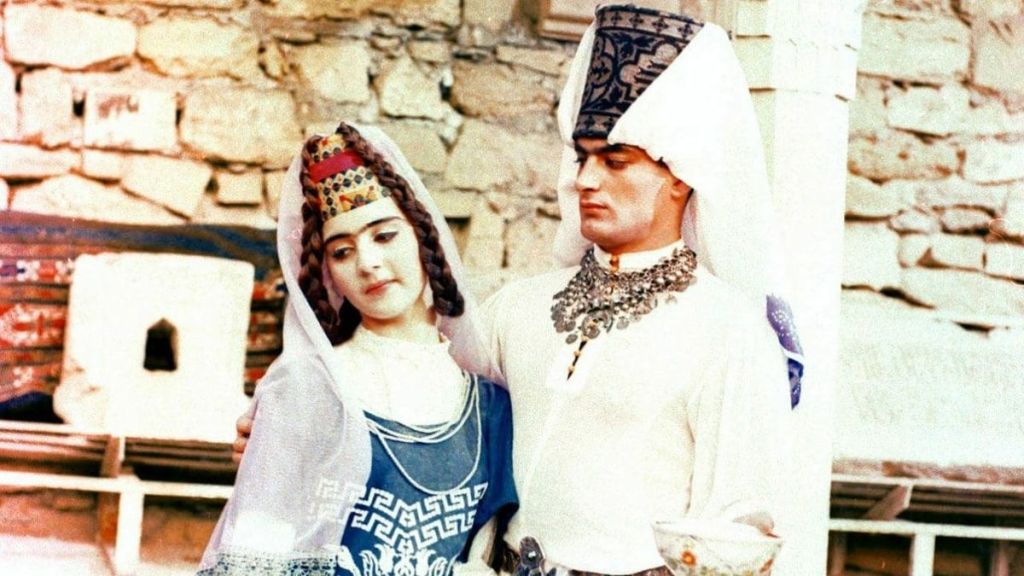Sergei Parajanov, a celebrated filmmaker of Armenian descent, is known for his unique and poetic cinematic language. He achieved international acclaim for his distinctive style in films like Shadows of Forgotten Ancestors and The Color of Pomegranates, both of which remain icons of global cinema for their visual and narrative innovation.
Born in Georgia to Armenian parents, Parajanov started his filmmaking career in Ukraine. His early works adhered to the socialist realism style of the Soviet Union. However, his desire for artistic independence propelled him to break away from these norms. This artistic rebellion was embodied in Shadows of Forgotten Ancestors, marking a turning point in his career and displaying his transition to a more symbolic and non-conventional form of storytelling.
His films delve into the rich tapestry of Armenian, Georgian, and Ukrainian culture, often imbued with elements of folklore, mythology, and religious symbolism. His approach to filmmaking was characterised by a rejection of traditional narrative structure. Instead, he opted for a tableau-like presentation of scenes, using vivid colours, intricate composition, and symbolic images to communicate his themes.
“Whoever tries to imitate me is lost”
Parajanov’s style is instantly recognisable for its dreamlike quality and intricate mise-en-scène. The manipulation of cinematic time and space, along with the use of symbolic and sometimes surreal imagery, create a uniquely immersive experience. The Color of Pomegranates epitomises his unique aesthetic; a film often considered more of a moving painting than a traditional narrative film.
Despite facing censorship and imprisonment during his lifetime, Parajanov’s work has profoundly influenced filmmakers both within and outside the former Soviet Union. Internationally acclaimed directors such as Tarkovsky and Fellini have expressed their admiration for his work. Furthermore, contemporary filmmakers worldwide continue to be inspired by Parajanov’s visual storytelling, testifying to his enduring influence on cinema. His legacy also led to a reappraisal of his work after his death, with critics recognising him as one of the most original and visionary directors in the history of cinema.

Sergei Parajanov (1924 – 1990)
Calculated Films:
- Shadows of Forgotten Ancestors (1965)
- The Colour of Pomegranates (1969)
- The Legend of Suram Fortress (1985)
Similar Filmmakers
- Alejandro Jodorowsky
- Aleksander Dovzhenko
- Andrei Tarkovsky
- Andrzej Zulawski
- Artavazd Peleshian
- Emir Kusturica
- Giorgi Shengelaia
- Glauber Rocha
- Kira Muratova
- Miklos Jancso
- Otar Iosseliani
- Peter Greenaway
- Tarsem Singh
- Tengiz Abuladze
- Terrence Malick
- Vytautas Zalakevicius
- Walerian Boroczwyk
- Yuri Ilyenko



Sergei Parajanov’s Top 5 Films Ranked
1. The Colour of Pomegranates (1969)
Genre: Experimental, Biographical, Surrealism

2. Shadows of Forgotten Ancestors (1965)
Genre: Period Drama, Romance, Ukrainian Poetic Cinema, Magical Realism

3. The Legend of Suram Fortress (1985)
Genre: Period Drama, Surrealism

4. Ashik Kerib (1988)
Genre: Period Drama, Fairy Tale, Surrealism

5. Arabesques on the Pirosmani Theme (1985)
Genre: Art Documentary

Sergei Parajanov: Themes and Style
Themes:
- Cultural Heritage: Parajanov’s films frequently celebrate and explore the rich cultural heritage of Armenia, Georgia, and Ukraine. He delves deep into the folklore, traditional music, art, and rituals of these regions, presenting them with authenticity and reverence.
- Spirituality & Religion: There’s a palpable spiritual dimension in his works, often intertwined with the exploration of religious motifs, rituals, and iconography pertinent to Orthodox Christianity.
- Love & Tragedy: Themes of love and tragedy are central in Parajanov’s narratives, often depicted as entangled with destiny and societal constraints. His characters usually undergo complex emotional journeys marked by love, loss, and transcendence.
- Artistic Freedom & Individualism: Parajanov’s works often embody a fierce sense of individualism and a quest for artistic freedom, mirroring his struggles against the oppressive Soviet regime that frequently targeted his creative expression.
Visual and Directing Styles:
- Tableau Vivant: Parajanov was known for employing the Tableau Vivant technique, creating visually arresting, static compositions that resemble living paintings. This allows him to communicate complex emotional and thematic layers within a single, meticulously crafted frame.
- Symbolism: His films are dense with symbolic imagery and metaphors derived from Eastern European and Caucasus folklore and religious traditions. Every object, colour, and gesture within the frame is loaded with specific, carefully considered meaning.
- Non-Linear Storytelling: Rejecting conventional narrative structures, Parajanov often embraced non-linear, episodic storytelling modes. His films might seem fragmented or elliptical, requiring viewers to engage actively in interpreting and connecting the visual and thematic dots.
- Collage of Arts: Integrating various art forms, Parajanov’s cinematic language encompasses poetry, painting, theatre, and music, creating a synesthetic experience that appeals to multiple senses simultaneously.
Directorial Signature:
- Visual Poetry: Parajanov’s directorial signature lies in his ability to transform cinematic space into a canvas of visual poetry. His films are not merely meant to be watched but experienced, as they immerse viewers in a hypnotic, dream-like state where imagery and emotions supersede linear logic and plot.
- Cultural Mosaic: His films function as a mosaic of the diverse cultural elements of Eastern Europe and the Caucasus. Parajanov meticulously integrates folklore, music, and art into his narrative structure, presenting a tapestry of cultural expressions and identities.
- Innovative Soundscapes: The director pays careful attention to the sound design in his films, often employing traditional music and natural sounds to create an atmospheric, immersive soundscape that complements his visual style.
Sergei Parajanov: The 168th Greatest Director




